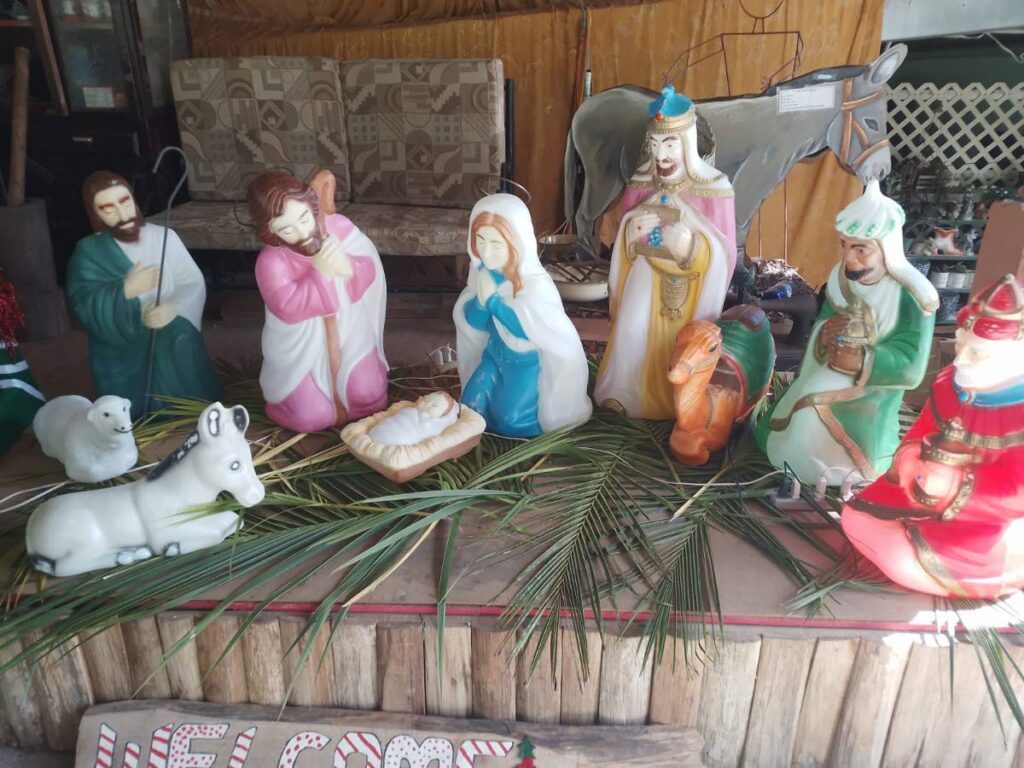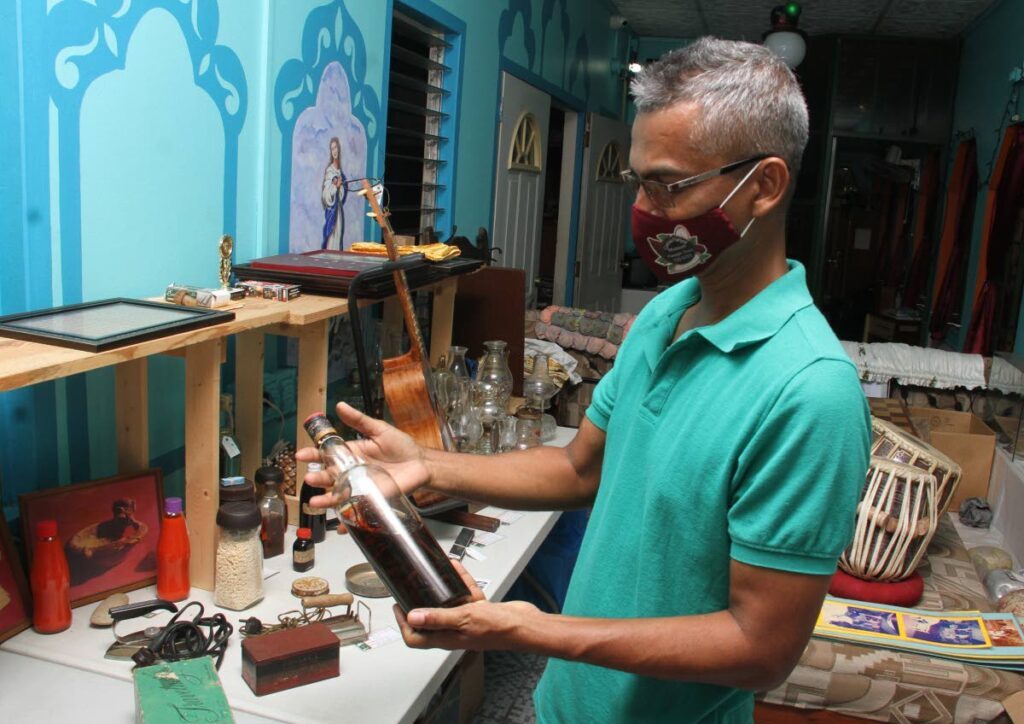|
BAVINA SOOKDEO In the village of Flanagin Town, art teacher Clive Teemul has found a way to marry history and the holiday spirit. Using his teaching experience and his knowledge of the cultural heritage of his community, Teemul has put together and curates the Cocoa Panyol Museum and Christmas Village. The Christmas village comprises almost entirely recycled and re-purposed materials such as plastic bottles, glass bottles, Styrofoam and scrap fabric. The traditional cartoon characters and Christmas figures are all hand-designed and hand-painted by Teemul. The museum contains artefacts, some of which were donated by people in the community. There is also a roadside display that is set in a separate area and offers spacious surroundings with ease of accessibility and movement in a clean, green environment. In addition to the display itself, visitors are treated to photo opportunities, a festive drink such as sorrel or hot chocolate, a short, guided tour of the museum and a small snack pack for children while stocks last. Some may be served home-made hops baked on banana leaves. Born and raised in Flanagin Town on rented property which was part of a cocoa estate, Teemul was the seventh of eight children. Together with his parents, he lived in what he describes as “a humble wooden dwelling.” As progress was made, the wooden structure was replaced with a concrete house. Curator Clive Teemul shows a bottle of snake/scorpion antidote, at his Cocoa Panyol Museum, Telemaque Road, Flanagin Town. - Angelo Marcelle “We grew up with sound family values and family cohesiveness,” he told Newsday.
“Our parents were hard-working to maintain the family stability…they were creative, enabling self-sufficiency in some ways. We never had Christmas decorations and gifts, except balloons while growing up. No tree, only some postcards hung on a string on the living-room wall. “As I grew older and began teaching, I was able to afford some decorations, tree, crèche. Each year I tried to add something new. My nieces and nephews anticipated visits here to see ‘what new Uncle Clive had’…their excitement never grew weak.” He said after his mother died in August 2012 and his father in June 2015, he did not decorate the house. Instead, he decided to take them to his school, Tabaquite Secondary, so his students could enjoy them. Eventually, he created a mini Christmas village in his art room, adding children’s art projects to the display. “I linked with other subject departments which were willing to add to the display. Some teachers did Christmas storytelling in the Christmas village during their lunchtimes.” He observed the reactions of students, and resolved to create something bigger and better for the children the following year. In 2016, together with a colleague who sourced raw materials, and the efforts of students and teachers from neighbouring primary schools, the Christmas village with the theme Being a child again this Christmas was opened. In 2017, Teemul saw the need for a permanent museum and worked toward the opening of Cocoa Panyol Museum. “In brainstorming the theme that year, I looked for ways in which Christmas of long ago influenced Christmas today. “As the thought of pastelles and parang echoed in my mind, I initially associated the Spanish connection, but as I examined it further, it dawned on me that the Venezuelan connection was evident...those who came in the mid 1800s were not pure Spanish, but a tri-racial or pardo group mixed with Amerindian/African/Spanish….they were the group known as the ‘panyols’ and the ones who worked the estates, like the one I lived on, were commonly called ‘cocoa panyols.’ It is with this realisation that I decided to name the museum Cocoa Panyol Museum.” Since the Christmas project and the museum concept developed at a phenomenal rate, in 2017 Teemul moved it to his home, where visitors could have easier access at their convenience rather than during confined hours at school. “I chose my home and yard where I can monitor and attend to its needs without stress or difficulty. “Also, I can easily link my discussions with the history of my own village. I can draw or attract people to a district which would normally be unknown to many Trinidadians. These efforts can open up rural travel and exploration by outsiders. “Flanagin Town is said to be at the centre of Trinidad as told from the days of World War II, when American pilots flew over the RC Church and used it as a landmark.” He said he faced some challenges when establishing the museum – from finding artefacts to reorganising home space and creating an inviting environment. But with time, the community and visitors contributed items, and Teemul’s resourcefulness turned garage and living-room spaces into museum corners. Glass cases, funded by visitor donations, now protect the artefacts, reducing maintenance. Teemul said initially, the number of members of the community visiting both the museum and Christmas display was extremely small, but last year there was an observable upward spike in villager visits at Christmas time. He also noted that a few villagers visited several times during the Christmas season. “Visitors from outside have been gradually increasing over the years,” he said. “The total visitors for December so far this year is 115,” which will most likely increase because the Christmas display runs until the evening of January 1, 2024. Teemul said visitors “...are overwhelmed and excited throughout their visit. “Upon entry recently one visitor who accompanied a tour group organised by the National Trust said when she reached and observed from the road she wondered, ‘What are we really going to do in this place for four hours?’…but upon entering and going through the planned activities, she quickly retracted that thought. “Many seniors share their personal experiences with us. We look forward to learning from visitors, not only imparting knowledge from the museum. Some visitors return with other persons whom they mobilised for a trip here. “Some visitors indicate that they came as a result of feedback from previous visitors, or from social media coverage and conventional media coverage. Some are returning to the place of their childhood and reuniting with family members through the museum efforts or even reuniting in the museum. “Some are brought to tears by standing in the presence of an artefact they realise belonged specifically to a grandparent or relative.” Teemul envisions expanding the village by adding interactive sessions and diversifying museum offerings. But, he said, there will be need for more media coverage and exposure to attract visitors. During the Christmas season the Cocoa Panyol Museum and Christmas Village is open daily from 10 am-10 pm. Outside of the Christmas season, it is open on weekends and public holidays from 1-5 pm. Special arrangements can be made for group and weekday bookings. Teemul said, “During the month of December there is no planned cost for drop-in visits: we rely on the goodness and generosity of visitors’ cash donations. “For drop-ins during the year, the same policy applies...donations are optional but highly appreciated. “For group visits, details and costs are discussed when making arrangements, depending on group size, age group and the package desired, as these visits require lengthy preparation and incur high costs.” Lunch is optional at an extra cost. He said all income goes towards accommodation for artefacts, acquiring additional artefacts and to provide additional infrastructure such as display units, and land preparation for future expansion. For more info call 733-5701 or visit the Facebook page Cocoa Panyol Museum. (Source: Newsday, Dec 16, 2023)
0 Comments
Leave a Reply. |
T&T news blogThe intent of this blog is to bring some news from home and other fun items. If you enjoy what you read, please leave us a comment.. Archives
May 2025
Categories
All
|



 RSS Feed
RSS Feed